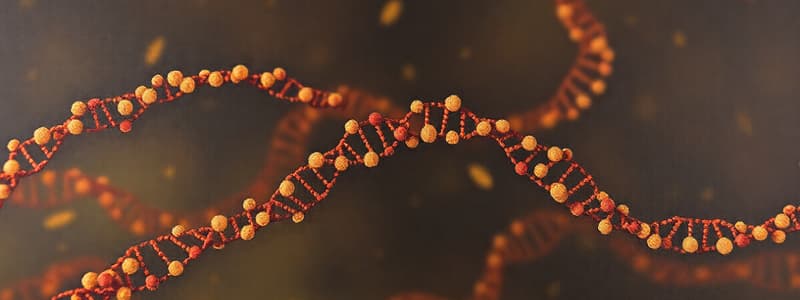Podcast
Questions and Answers
Which of the following mechanisms directly regulates gene expression by affecting the processing of mRNA?
Which of the following mechanisms directly regulates gene expression by affecting the processing of mRNA?
- Transcription initiation
- mRNA splicing (correct)
- Histone modification
- Premature transcription termination
What is a primary function of histone modification in gene expression regulation?
What is a primary function of histone modification in gene expression regulation?
- Directly altering the sequence of mRNA
- Initiating premature termination of transcription
- Regulating the rate of protein translation
- Controlling access to DNA for transcription (correct)
Which process involves the premature cessation of RNA synthesis resulting in a truncated transcript?
Which process involves the premature cessation of RNA synthesis resulting in a truncated transcript?
- Premature transcription termination (correct)
- mRNA splicing
- Transcription initiation
- Transcription termination
According to the provided material, what is the broad definition of aging at the biological level?
According to the provided material, what is the broad definition of aging at the biological level?
Which of the following directly affects the abundance of mRNA available for translation?
Which of the following directly affects the abundance of mRNA available for translation?
If a gene is 'switched off', at which of the following levels could this regulation occur?
If a gene is 'switched off', at which of the following levels could this regulation occur?
Which of these is NOT explicitly defined as a hallmark of aging based on the lecture material provided?
Which of these is NOT explicitly defined as a hallmark of aging based on the lecture material provided?
Which regulatory mechanism has the potential to change which exon sequences are present in a mature mRNA molecule?
Which regulatory mechanism has the potential to change which exon sequences are present in a mature mRNA molecule?
What do 'senescence' and 'decline of biological functions' refer to, in the context of the given material?
What do 'senescence' and 'decline of biological functions' refer to, in the context of the given material?
Which of the following does NOT directly control the amount of protein produced from a gene?
Which of the following does NOT directly control the amount of protein produced from a gene?
Flashcards
Gene Regulation
Gene Regulation
The process of turning on or off genes to control the production of proteins.
Transcription Initiation
Transcription Initiation
The process of initiating transcription, the first step in gene expression.
Premature Transcription Termination (PTT)
Premature Transcription Termination (PTT)
A mechanism where transcription is prematurely stopped, preventing a full mRNA transcript from being made.
mRNA Splicing
mRNA Splicing
Signup and view all the flashcards
Translation
Translation
Signup and view all the flashcards
Regulation by Access to DNA
Regulation by Access to DNA
Signup and view all the flashcards
Histone Modification
Histone Modification
Signup and view all the flashcards
Aging
Aging
Signup and view all the flashcards
Hallmarks of Aging
Hallmarks of Aging
Signup and view all the flashcards
Biological Aging
Biological Aging
Signup and view all the flashcards
Study Notes
NFNF1613 - Regulation of Gene Expression
- Course is about regulation of gene expression
- Lecture objectives include understanding gene activation/suppression, gene regulation at different levels, and genetic changes associated with cellular aging.
Flow of Genetic Information
- DNA (deoxyribonucleic acid) contains information
- This info is transcribed into mRNA (messenger RNA)
- The mRNA sequence is used to synthesize proteins with specific amino acid sequences.
- mRNA carries genetic information for protein synthesis from DNA to ribosomes
- tRNA (transfer RNA) transfers specific amino acids to ribosomes
- Ribosomes assemble amino acids according to mRNA instructions
- Proteins carry out various cellular functions
Definitions
- Gene expression is the process where gene information is utilized to create proteins (or non-coding RNA).
- Gene expression is comparable to a switch, turning genes "on" or "off" and controlling the production of proteins.
- Gene expression is a "volume control" influencing the amount of protein/RNA produced.
- Regulation of gene expression changes under different conditions and cell types.
Gene Regulation Mechanisms
- Regulation by Transcription Initiation: Specific transcription factors bind to DNA, influencing RNA polymerase activity. This initiates the process of transcription which produces mRNA.
- Regulation by Transcription Termination: This process regulates the ending of the transcription process. Some examples are premature termination and the production of a shorter/different protein.
- Regulation by mRNA Splicing: The removal of introns and joining of exons in mRNA molecules, creating alternative versions of proteins. This creates different isoforms of the same protein.
- Regulation by Translation: eIF-2 phosphorylation can regulate protein translation, altering whether a gene is "on" or "off."
- Regulation by Access to DNA: Modifying chromatin structure alters DNA accessibility, affecting gene expression. Examples include histone acetylation and methylation.
Aging and Gene Expression
- Aging is progressive physiological changes leading to organism decline.
- Aging is the result of damage buildup over time (e.g., molecular and cellular damage).
- Hallmarks of aging include genomic instability, telomere attrition, epigenetic alterations, loss of proteostasis, deregulated nutrient sensing, mitochondrial dysfunction, cellular senescence, stem cell exhaustion, and altered intercellular communication.
References
- Lippincott's Illustrated Reviews: Biochemistry(6th Edition) is a cited reference.
Studying That Suits You
Use AI to generate personalized quizzes and flashcards to suit your learning preferences.




